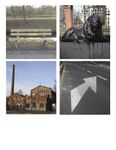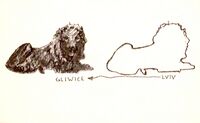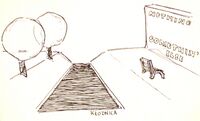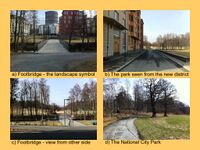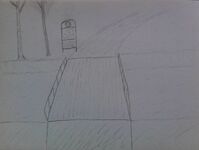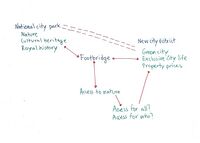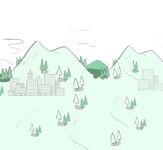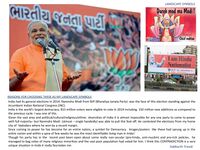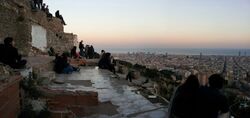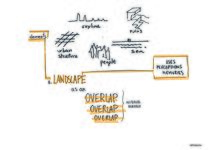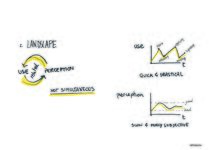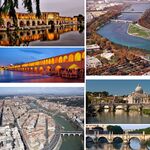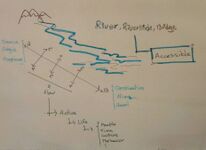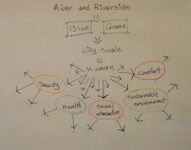LED Seminar 2016 - Landscape Symbols Reflection Group H
Landscape Symbol 1- Gliwice Poland, Nicolas Reibel
Representations and analytical drawings
in addition to your initial visual please add two further analytical drawings of your symbol
Reflections
Please write a 250 words text reflecting on the following questions, you can also take ideas from your group members into account
- How and why did the symbols you identify appear in your landscape?
- Did their meaning change along with socio-political, economic, environmental or cultural changes in your region, or country?
- What do these symbols mean to you today? Are they meaningful to more than just one cultural group? Are they shared across cultures?
What is most important about this bench is the direction it faces. None of the benches in the city face the Kłodnica River, which bisects Gliwice. A major feature of the landscape, goes unnoticed on a daily basis. The bench stands as a symbol of “the gaze”, determining which landscapes have value. This highly polluted river is a point of shame for both the populace and the municipality. Neither group has addressed the issue, which lends to the bench's symbol of inaction.
The lion was brought to the city center, after initially being installed in front of the local steel mill. The mill has since shut down. The lion has a unique meaning to the populace, as they were displaced from their former home, Lviv Ukraine, and forced to reestablish themselves here in Gliwice, a former German city. Lviv is known as the city of the lion, and it's name relates to the Polish word for lion “lew.”
The merge symbol is taken from the on-ramp to the newly finished intercity highway (DTS) which links the major cities of the Silesian region. This new infrastructure ties the landscape, economies and communities together, merging the previously independent municipalities. These changes mirror another important merger, Poland's admission to the EU, which has greatly impacted the local economy. It even subsidized the DTS project.
This former factory is now a cultural space for music and exhibitions. These red brick structures litter the landscape, a majority abandoned, some appropriated for other means. They signify the former blue collar – industrial identity of the city. The red brick architecture in the city is often identified by the citizens as “German”, and emphasize that it originated from another culture. These buildings undoubtedly have another identity for the German tourists who visit the region in the summer.
Landscape Symbol 2- Stockholm, Emil Buzzi
Representations and analytical drawings
in addition to your initial visual please add two further analytical drawings of your symbol
Reflections
The footbridge, a very subtle feature between the new city scape and the National City Park, represents the very intimate connection between these two very different landscapes. When looking at the small bridge with this in mind, it looks more welcoming than ever. However, this footbridge is a very new part of the landscape. Before the new city district was built, an old footbridge some hundred meters along the stream was available, but this new footbridge is positioned so that the avenue ends in harmony with the bridge, thus making the National City Park much more integrated with the new city district.
The meaning of this symbol, of the footbridge, is more complex than only its structure. In one way, it represents easy access to nature, cultural heritage and the royal history of the area. But with this, another question arises, access for whom? As the new city district is branded as a green city, the property prices suggest an exclusive city life where only certain parts of society are welcome. In this light, the access to nature looks more as a key feature of the greenness and exclusivity of the new city rather than an increase in the accessibility for all.
Landscape Symbol 3- Maliheh Shahghadami
Representations and analytical drawings
in addition to your initial visual please add two further analytical drawings of your symbol
- GroupI slide2.JPG
slide 2
- GroupI slide3.JPG
slide 3
Reflections
Please write a 250 words text reflecting on the following questions, you can also take ideas from your group members into account
- How and why did the symbols you identify appear in your landscape?
- Did their meaning change along with socio-political, economic, environmental or cultural changes in your region, or country?
- What do these symbols mean to you today? Are they meaningful to more than just one cultural group? Are they shared across cultures?
add your text here
Landscape Symbol 4- Nardena Modi, Siddharth Trivedi
Representations and analytical drawings
in addition to your initial visual please add two further analytical drawings of your symbol
- GroupI slide2.JPG
slide 2
- GroupI slide3.JPG
slide 3
Reflections
Please write a 250 words text reflecting on the following questions, you can also take ideas from your group members into account
- How and why did the symbols you identify appear in your landscape?
- Did their meaning change along with socio-political, economic, environmental or cultural changes in your region, or country?
- What do these symbols mean to you today? Are they meaningful to more than just one cultural group? Are they shared across cultures?
add your text here
Landscape Symbol 5-Turo Rovira Barcelona, Margherita Galante
Representations and analytical drawings
in addition to your initial visual please add two further analytical drawings of your symbol
This picture is taken from a hight point of Barcelona, called Turò de La Rovira. It’s a place close to my actual residence where I used to go walking to take fresh air on the sunset and see the 360º view of the city. From this picture, we can appreciate some of Barcelona skyline with different singular architectures, its orthogonal urban structure and the Mediterranean sea, but also house ruins, brick walls and people chilling out during the sunset. This lasts elements occupy more than a half of my picture because I think they are really important for understand the historical heritage and the contemporary perception of these landscape symbols.
The hill was originally an Iberian settlement, then during the spanish civil war was an antiaircraft batter. Later on, it became the location for summerhouses and small houses with gardens connected to the stone extraction industry of the surroundings. Finally, in the post war, a strong immigration from south of Spain colonised the site with precarious houses until the moving of its inhabitant in proper social housing in the lasts years. Today the site is an open air historical museum.
At present, there is a strong conflict taking place between neighbourhood and massive tourism all around the city. Massive tourism had modified habits, economy and uses for local people. Five years ago nobody know this place and it was a peaceful landscape observatory on the city, suddenly a hight tourists presence arrive and change completely this atmosphere. It was a quick change and inhabitant still have to accept to share this heritage with tourists and tourist have to learn to travel respectfully with inhabitants.
In conclusion, for me this picture represents not only an overlap of uses, but even more a superposition of memories and perceptions of Turò de la Rovira landscapes in time. Also it helps me to make a reflection of the current unsustainable tourism model opted by the city.
Landscape Symbol 6-Rivers, Reihaneh Rafiemanzelat
Representations and analytical drawings
in addition to your initial visual please add two further analytical drawings of your symbol
Rivers are one of the natural symbols of landscape. they can be realized different in shape, deep, and characteristics in every parts of them.
these photo are related to Isfahan my hometown and Rome the city that I live there now. River, its bridges and sidewalk became symbol of landscape for me as in my daily tripe I passed over them and every times of day it looks different and show me some thing new.
river and its natural environment could be known as of Blue and Green infrastructure of landscape design. it will change by time, culture and human behaviors.
accessibility is the landscape symbol as well. rivers and the bridges on them which mostly shown by curve and straight line in graphical drawing, making access from one point to other point.
river and its nature in the meaning could be different for people base on their realization of the environment, mods and culture.
Group reflection
Please add a summary of your group reflection here
